Data Breach and its Impact on the Business Environment Report
VerifiedAdded on 2023/04/07
|15
|3044
|427
Report
AI Summary
This report provides a comprehensive analysis of data breaches and their impact on the business environment. It begins by defining data breaches and outlining the phases involved in such breaches, including incursion, discovery, capture, and exfiltration. The report then delves into the current issues surrounding data breaches, discussing professional, social, and ethical implications. Professional issues include the breaching of personally identifiable information, financial data, competitive information, and IT security data. Social issues encompass the stealing of passwords and manipulation to obtain data, while ethical issues involve invasive data processing techniques and the processing of personal data. Furthermore, the report identifies relevant technologies and protocols such as encryption and hardware authentication, along with their weaknesses and potential impacts on data breaches. Finally, the report offers relevant solutions to mitigate data breach risks, including the protection of information, reduction of data transfer, restriction in downloading, file shredding, banning of unencrypted devices, secured data transfer, and automation of security measures.
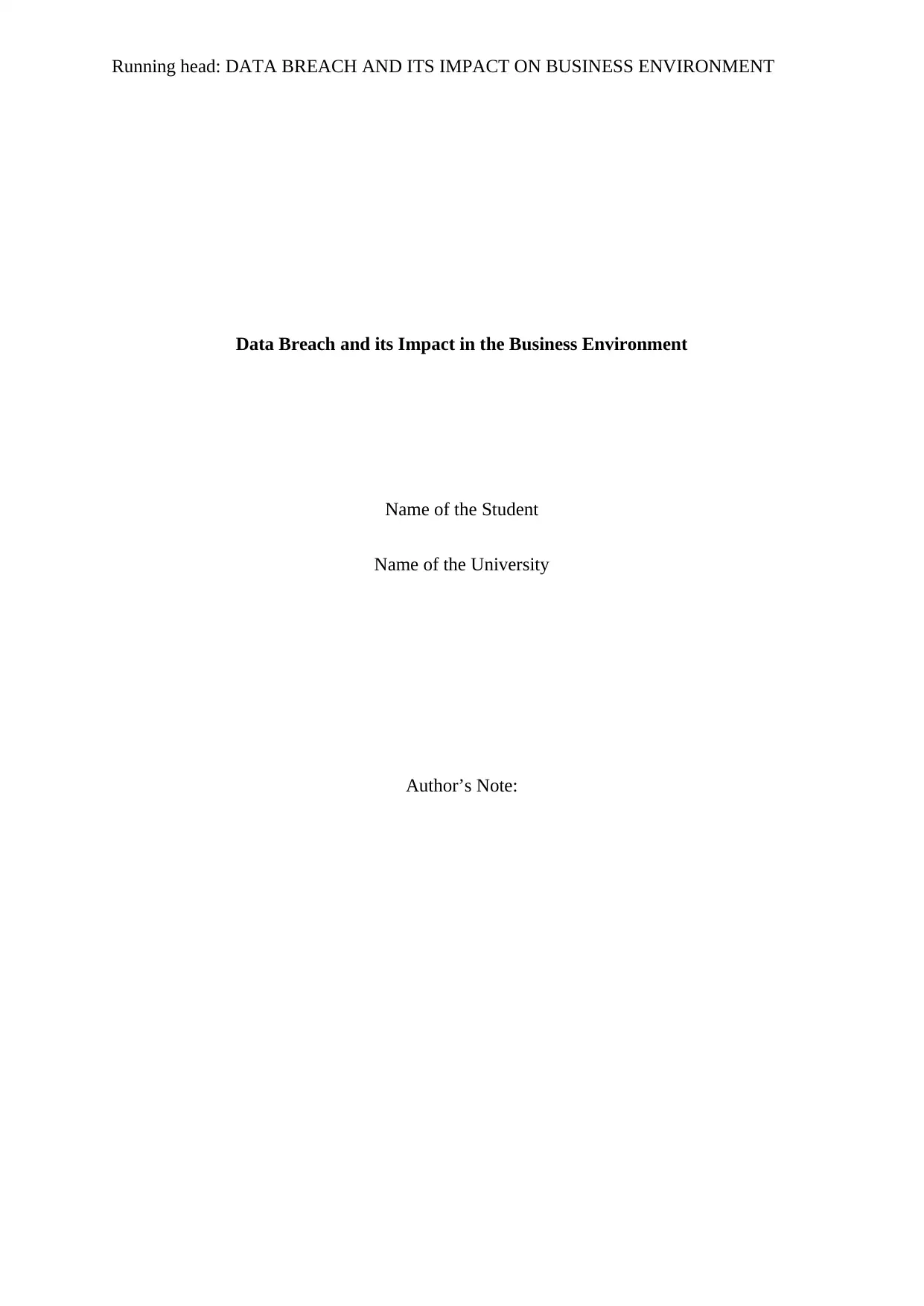
Running head: DATA BREACH AND ITS IMPACT ON BUSINESS ENVIRONMENT
Data Breach and its Impact in the Business Environment
Name of the Student
Name of the University
Author’s Note:
Data Breach and its Impact in the Business Environment
Name of the Student
Name of the University
Author’s Note:
Paraphrase This Document
Need a fresh take? Get an instant paraphrase of this document with our AI Paraphraser
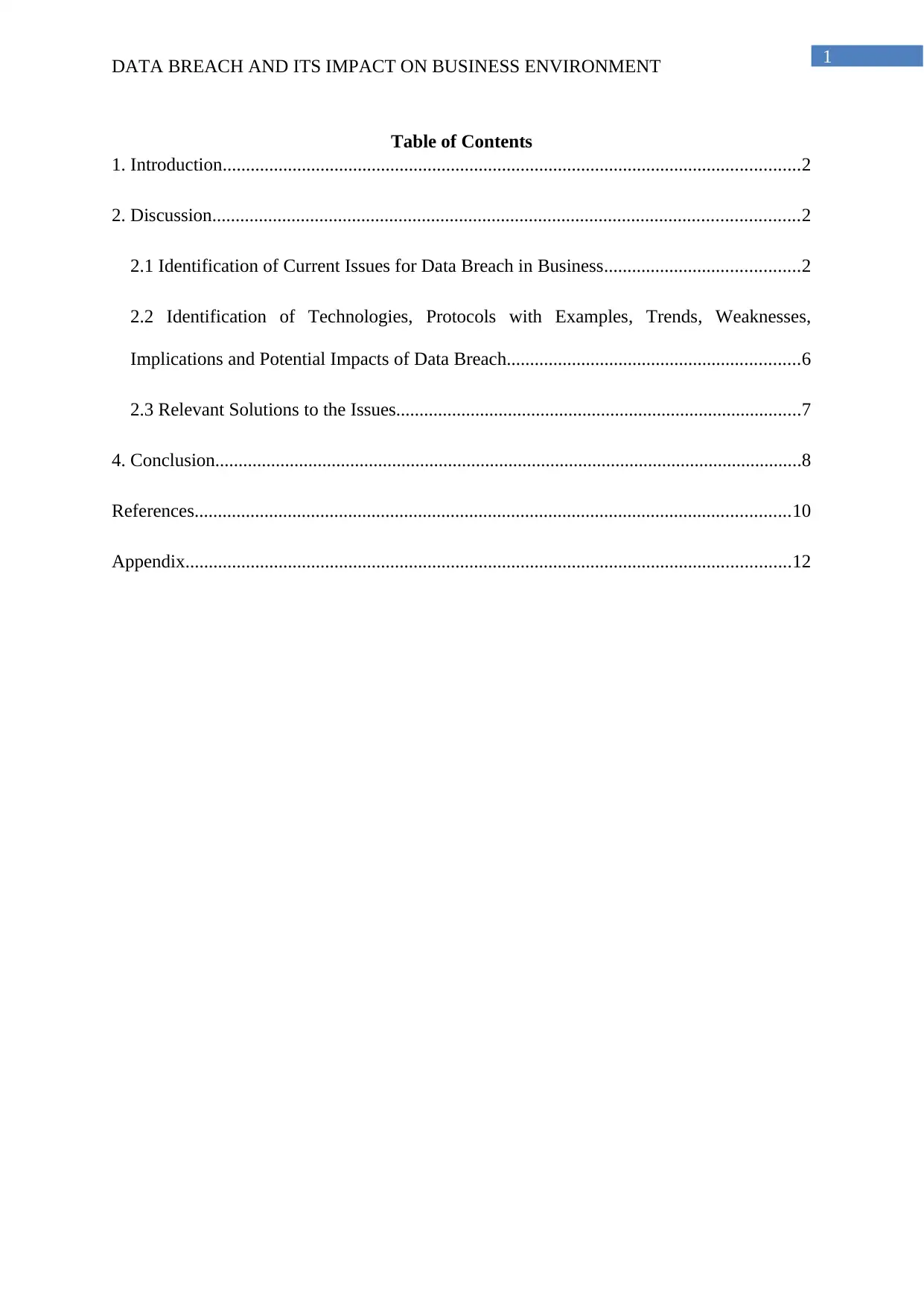
1
DATA BREACH AND ITS IMPACT ON BUSINESS ENVIRONMENT
Table of Contents
1. Introduction............................................................................................................................2
2. Discussion..............................................................................................................................2
2.1 Identification of Current Issues for Data Breach in Business..........................................2
2.2 Identification of Technologies, Protocols with Examples, Trends, Weaknesses,
Implications and Potential Impacts of Data Breach...............................................................6
2.3 Relevant Solutions to the Issues.......................................................................................7
4. Conclusion..............................................................................................................................8
References................................................................................................................................10
Appendix..................................................................................................................................12
DATA BREACH AND ITS IMPACT ON BUSINESS ENVIRONMENT
Table of Contents
1. Introduction............................................................................................................................2
2. Discussion..............................................................................................................................2
2.1 Identification of Current Issues for Data Breach in Business..........................................2
2.2 Identification of Technologies, Protocols with Examples, Trends, Weaknesses,
Implications and Potential Impacts of Data Breach...............................................................6
2.3 Relevant Solutions to the Issues.......................................................................................7
4. Conclusion..............................................................................................................................8
References................................................................................................................................10
Appendix..................................................................................................................................12
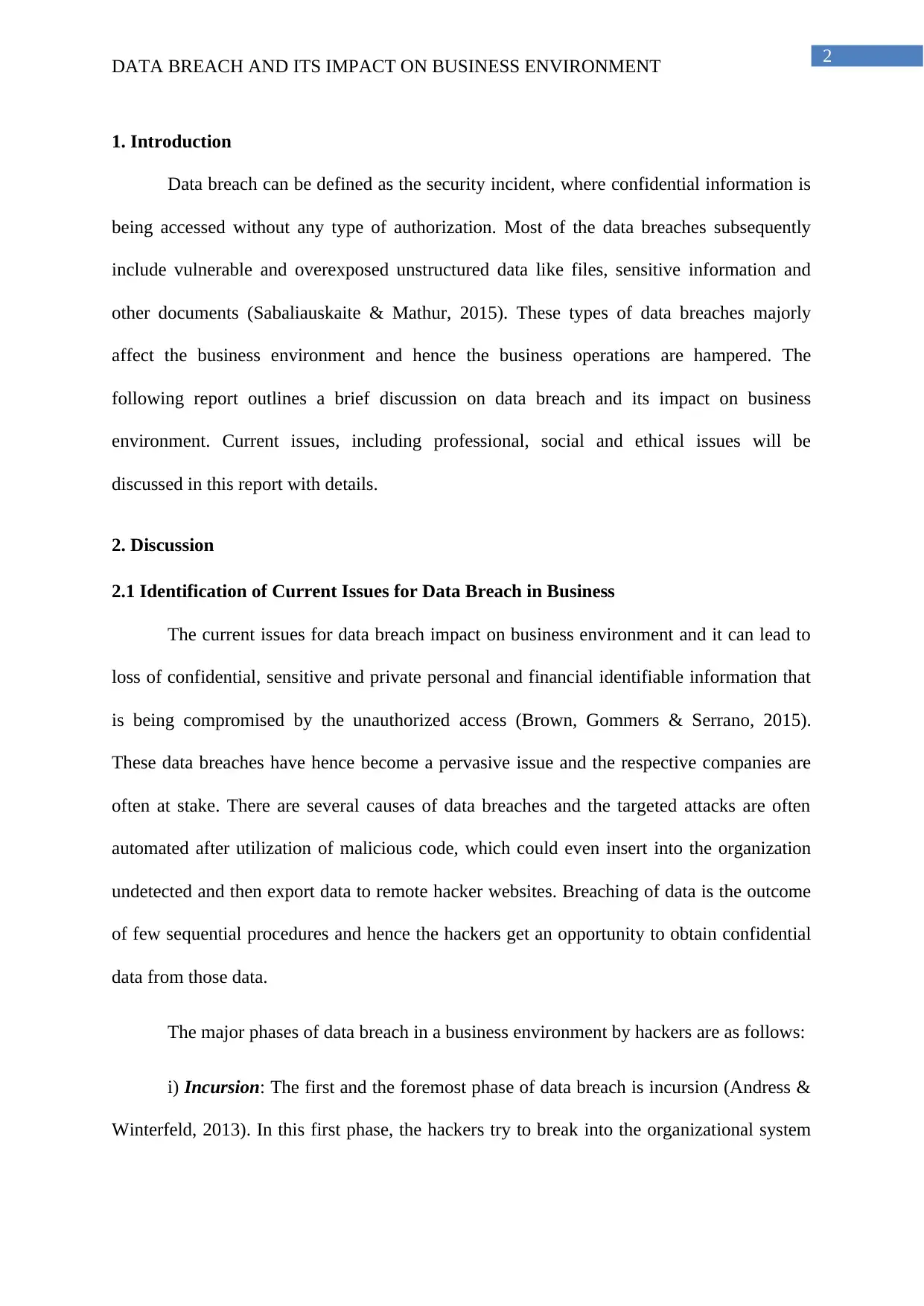
2
DATA BREACH AND ITS IMPACT ON BUSINESS ENVIRONMENT
1. Introduction
Data breach can be defined as the security incident, where confidential information is
being accessed without any type of authorization. Most of the data breaches subsequently
include vulnerable and overexposed unstructured data like files, sensitive information and
other documents (Sabaliauskaite & Mathur, 2015). These types of data breaches majorly
affect the business environment and hence the business operations are hampered. The
following report outlines a brief discussion on data breach and its impact on business
environment. Current issues, including professional, social and ethical issues will be
discussed in this report with details.
2. Discussion
2.1 Identification of Current Issues for Data Breach in Business
The current issues for data breach impact on business environment and it can lead to
loss of confidential, sensitive and private personal and financial identifiable information that
is being compromised by the unauthorized access (Brown, Gommers & Serrano, 2015).
These data breaches have hence become a pervasive issue and the respective companies are
often at stake. There are several causes of data breaches and the targeted attacks are often
automated after utilization of malicious code, which could even insert into the organization
undetected and then export data to remote hacker websites. Breaching of data is the outcome
of few sequential procedures and hence the hackers get an opportunity to obtain confidential
data from those data.
The major phases of data breach in a business environment by hackers are as follows:
i) Incursion: The first and the foremost phase of data breach is incursion (Andress &
Winterfeld, 2013). In this first phase, the hackers try to break into the organizational system
DATA BREACH AND ITS IMPACT ON BUSINESS ENVIRONMENT
1. Introduction
Data breach can be defined as the security incident, where confidential information is
being accessed without any type of authorization. Most of the data breaches subsequently
include vulnerable and overexposed unstructured data like files, sensitive information and
other documents (Sabaliauskaite & Mathur, 2015). These types of data breaches majorly
affect the business environment and hence the business operations are hampered. The
following report outlines a brief discussion on data breach and its impact on business
environment. Current issues, including professional, social and ethical issues will be
discussed in this report with details.
2. Discussion
2.1 Identification of Current Issues for Data Breach in Business
The current issues for data breach impact on business environment and it can lead to
loss of confidential, sensitive and private personal and financial identifiable information that
is being compromised by the unauthorized access (Brown, Gommers & Serrano, 2015).
These data breaches have hence become a pervasive issue and the respective companies are
often at stake. There are several causes of data breaches and the targeted attacks are often
automated after utilization of malicious code, which could even insert into the organization
undetected and then export data to remote hacker websites. Breaching of data is the outcome
of few sequential procedures and hence the hackers get an opportunity to obtain confidential
data from those data.
The major phases of data breach in a business environment by hackers are as follows:
i) Incursion: The first and the foremost phase of data breach is incursion (Andress &
Winterfeld, 2013). In this first phase, the hackers try to break into the organizational system
⊘ This is a preview!⊘
Do you want full access?
Subscribe today to unlock all pages.

Trusted by 1+ million students worldwide
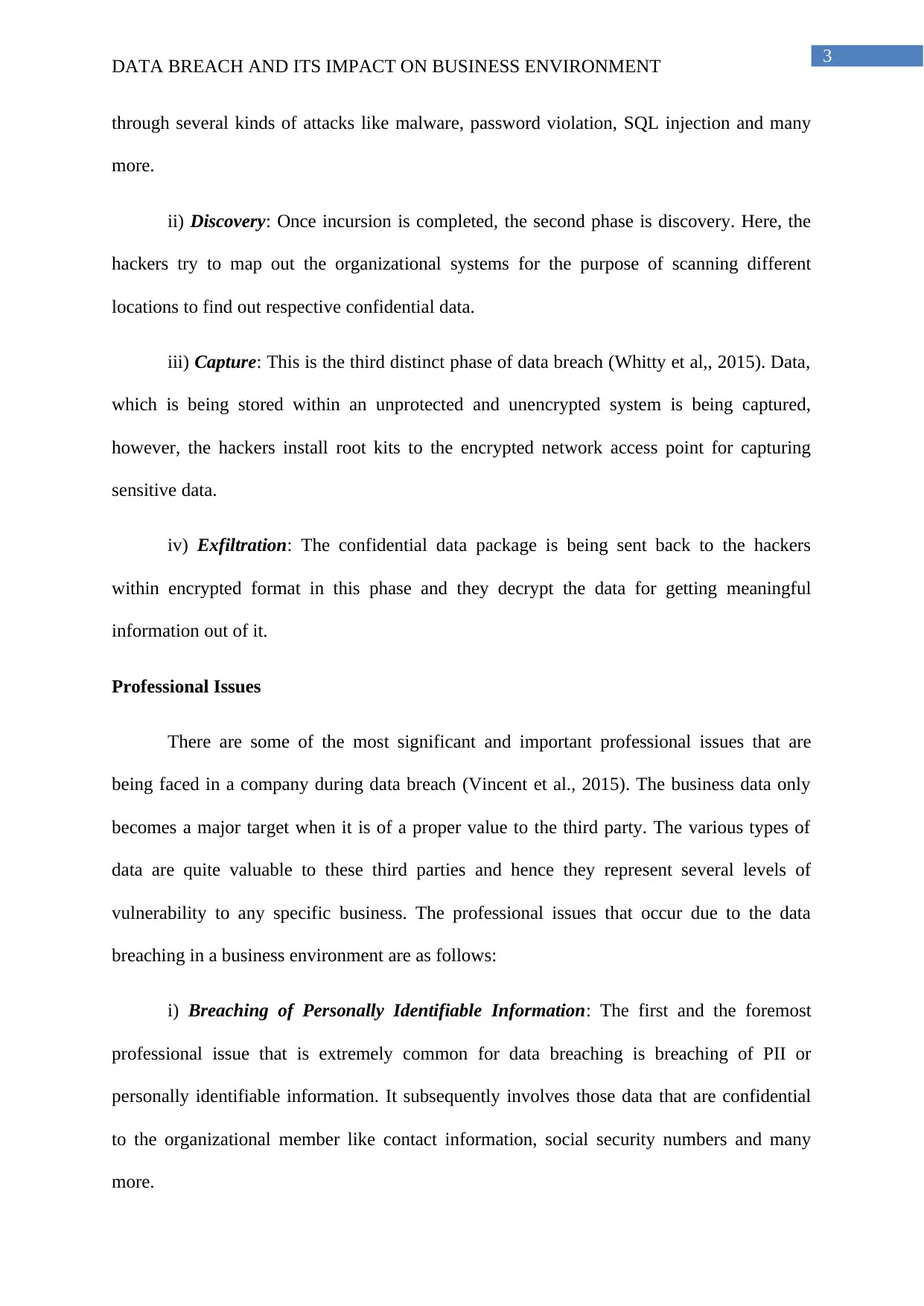
3
DATA BREACH AND ITS IMPACT ON BUSINESS ENVIRONMENT
through several kinds of attacks like malware, password violation, SQL injection and many
more.
ii) Discovery: Once incursion is completed, the second phase is discovery. Here, the
hackers try to map out the organizational systems for the purpose of scanning different
locations to find out respective confidential data.
iii) Capture: This is the third distinct phase of data breach (Whitty et al,, 2015). Data,
which is being stored within an unprotected and unencrypted system is being captured,
however, the hackers install root kits to the encrypted network access point for capturing
sensitive data.
iv) Exfiltration: The confidential data package is being sent back to the hackers
within encrypted format in this phase and they decrypt the data for getting meaningful
information out of it.
Professional Issues
There are some of the most significant and important professional issues that are
being faced in a company during data breach (Vincent et al., 2015). The business data only
becomes a major target when it is of a proper value to the third party. The various types of
data are quite valuable to these third parties and hence they represent several levels of
vulnerability to any specific business. The professional issues that occur due to the data
breaching in a business environment are as follows:
i) Breaching of Personally Identifiable Information: The first and the foremost
professional issue that is extremely common for data breaching is breaching of PII or
personally identifiable information. It subsequently involves those data that are confidential
to the organizational member like contact information, social security numbers and many
more.
DATA BREACH AND ITS IMPACT ON BUSINESS ENVIRONMENT
through several kinds of attacks like malware, password violation, SQL injection and many
more.
ii) Discovery: Once incursion is completed, the second phase is discovery. Here, the
hackers try to map out the organizational systems for the purpose of scanning different
locations to find out respective confidential data.
iii) Capture: This is the third distinct phase of data breach (Whitty et al,, 2015). Data,
which is being stored within an unprotected and unencrypted system is being captured,
however, the hackers install root kits to the encrypted network access point for capturing
sensitive data.
iv) Exfiltration: The confidential data package is being sent back to the hackers
within encrypted format in this phase and they decrypt the data for getting meaningful
information out of it.
Professional Issues
There are some of the most significant and important professional issues that are
being faced in a company during data breach (Vincent et al., 2015). The business data only
becomes a major target when it is of a proper value to the third party. The various types of
data are quite valuable to these third parties and hence they represent several levels of
vulnerability to any specific business. The professional issues that occur due to the data
breaching in a business environment are as follows:
i) Breaching of Personally Identifiable Information: The first and the foremost
professional issue that is extremely common for data breaching is breaching of PII or
personally identifiable information. It subsequently involves those data that are confidential
to the organizational member like contact information, social security numbers and many
more.
Paraphrase This Document
Need a fresh take? Get an instant paraphrase of this document with our AI Paraphraser
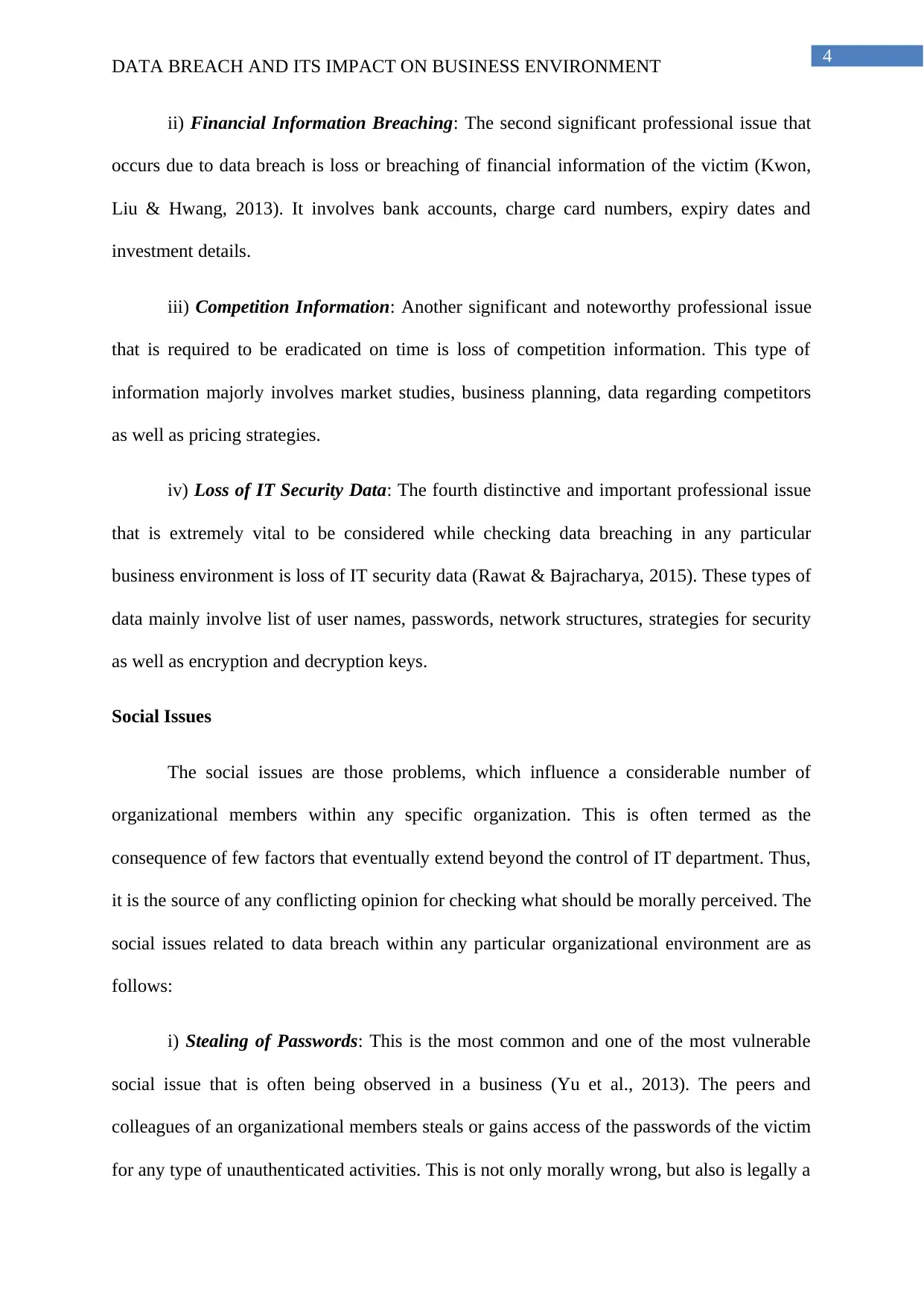
4
DATA BREACH AND ITS IMPACT ON BUSINESS ENVIRONMENT
ii) Financial Information Breaching: The second significant professional issue that
occurs due to data breach is loss or breaching of financial information of the victim (Kwon,
Liu & Hwang, 2013). It involves bank accounts, charge card numbers, expiry dates and
investment details.
iii) Competition Information: Another significant and noteworthy professional issue
that is required to be eradicated on time is loss of competition information. This type of
information majorly involves market studies, business planning, data regarding competitors
as well as pricing strategies.
iv) Loss of IT Security Data: The fourth distinctive and important professional issue
that is extremely vital to be considered while checking data breaching in any particular
business environment is loss of IT security data (Rawat & Bajracharya, 2015). These types of
data mainly involve list of user names, passwords, network structures, strategies for security
as well as encryption and decryption keys.
Social Issues
The social issues are those problems, which influence a considerable number of
organizational members within any specific organization. This is often termed as the
consequence of few factors that eventually extend beyond the control of IT department. Thus,
it is the source of any conflicting opinion for checking what should be morally perceived. The
social issues related to data breach within any particular organizational environment are as
follows:
i) Stealing of Passwords: This is the most common and one of the most vulnerable
social issue that is often being observed in a business (Yu et al., 2013). The peers and
colleagues of an organizational members steals or gains access of the passwords of the victim
for any type of unauthenticated activities. This is not only morally wrong, but also is legally a
DATA BREACH AND ITS IMPACT ON BUSINESS ENVIRONMENT
ii) Financial Information Breaching: The second significant professional issue that
occurs due to data breach is loss or breaching of financial information of the victim (Kwon,
Liu & Hwang, 2013). It involves bank accounts, charge card numbers, expiry dates and
investment details.
iii) Competition Information: Another significant and noteworthy professional issue
that is required to be eradicated on time is loss of competition information. This type of
information majorly involves market studies, business planning, data regarding competitors
as well as pricing strategies.
iv) Loss of IT Security Data: The fourth distinctive and important professional issue
that is extremely vital to be considered while checking data breaching in any particular
business environment is loss of IT security data (Rawat & Bajracharya, 2015). These types of
data mainly involve list of user names, passwords, network structures, strategies for security
as well as encryption and decryption keys.
Social Issues
The social issues are those problems, which influence a considerable number of
organizational members within any specific organization. This is often termed as the
consequence of few factors that eventually extend beyond the control of IT department. Thus,
it is the source of any conflicting opinion for checking what should be morally perceived. The
social issues related to data breach within any particular organizational environment are as
follows:
i) Stealing of Passwords: This is the most common and one of the most vulnerable
social issue that is often being observed in a business (Yu et al., 2013). The peers and
colleagues of an organizational members steals or gains access of the passwords of the victim
for any type of unauthenticated activities. This is not only morally wrong, but also is legally a
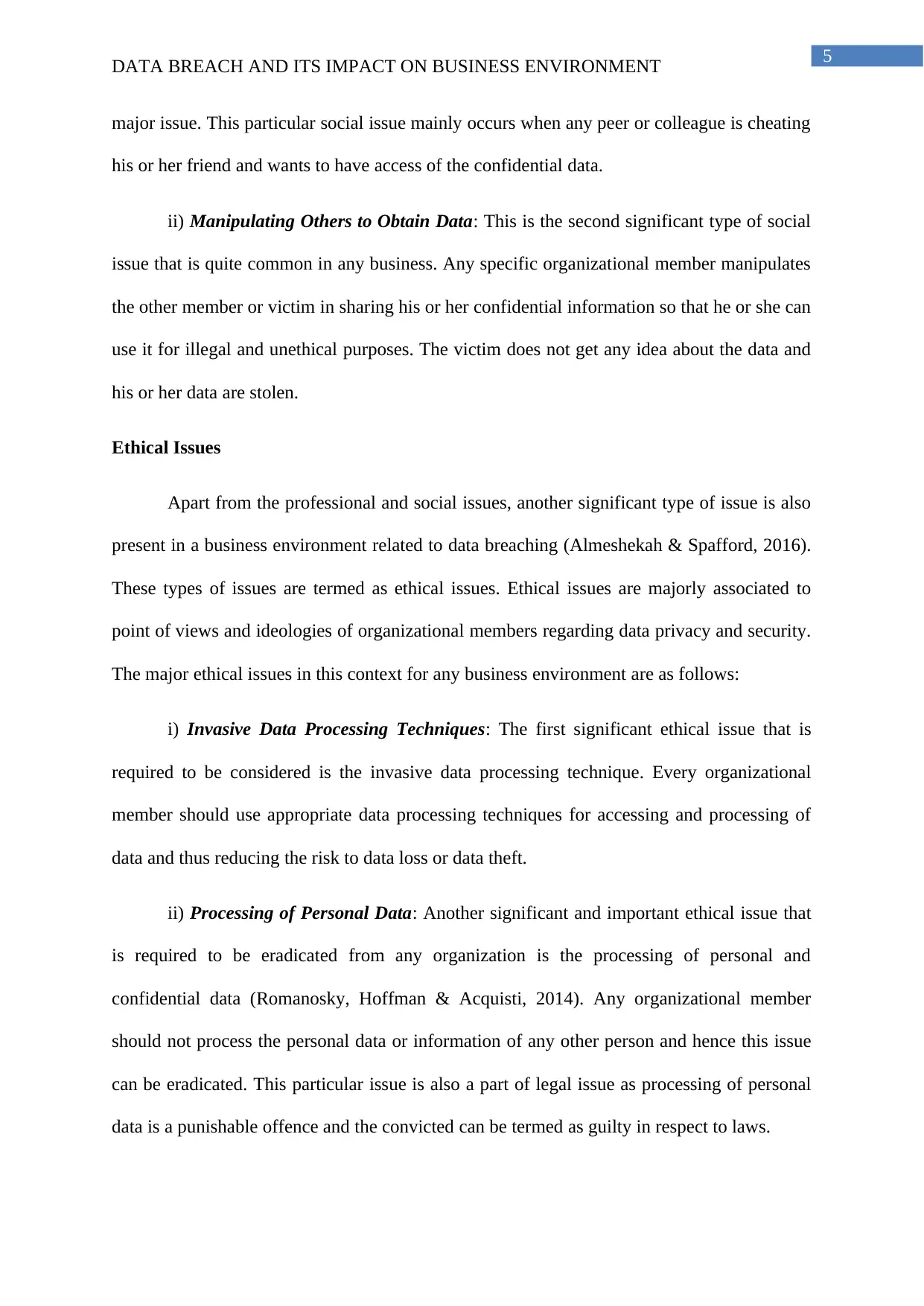
5
DATA BREACH AND ITS IMPACT ON BUSINESS ENVIRONMENT
major issue. This particular social issue mainly occurs when any peer or colleague is cheating
his or her friend and wants to have access of the confidential data.
ii) Manipulating Others to Obtain Data: This is the second significant type of social
issue that is quite common in any business. Any specific organizational member manipulates
the other member or victim in sharing his or her confidential information so that he or she can
use it for illegal and unethical purposes. The victim does not get any idea about the data and
his or her data are stolen.
Ethical Issues
Apart from the professional and social issues, another significant type of issue is also
present in a business environment related to data breaching (Almeshekah & Spafford, 2016).
These types of issues are termed as ethical issues. Ethical issues are majorly associated to
point of views and ideologies of organizational members regarding data privacy and security.
The major ethical issues in this context for any business environment are as follows:
i) Invasive Data Processing Techniques: The first significant ethical issue that is
required to be considered is the invasive data processing technique. Every organizational
member should use appropriate data processing techniques for accessing and processing of
data and thus reducing the risk to data loss or data theft.
ii) Processing of Personal Data: Another significant and important ethical issue that
is required to be eradicated from any organization is the processing of personal and
confidential data (Romanosky, Hoffman & Acquisti, 2014). Any organizational member
should not process the personal data or information of any other person and hence this issue
can be eradicated. This particular issue is also a part of legal issue as processing of personal
data is a punishable offence and the convicted can be termed as guilty in respect to laws.
DATA BREACH AND ITS IMPACT ON BUSINESS ENVIRONMENT
major issue. This particular social issue mainly occurs when any peer or colleague is cheating
his or her friend and wants to have access of the confidential data.
ii) Manipulating Others to Obtain Data: This is the second significant type of social
issue that is quite common in any business. Any specific organizational member manipulates
the other member or victim in sharing his or her confidential information so that he or she can
use it for illegal and unethical purposes. The victim does not get any idea about the data and
his or her data are stolen.
Ethical Issues
Apart from the professional and social issues, another significant type of issue is also
present in a business environment related to data breaching (Almeshekah & Spafford, 2016).
These types of issues are termed as ethical issues. Ethical issues are majorly associated to
point of views and ideologies of organizational members regarding data privacy and security.
The major ethical issues in this context for any business environment are as follows:
i) Invasive Data Processing Techniques: The first significant ethical issue that is
required to be considered is the invasive data processing technique. Every organizational
member should use appropriate data processing techniques for accessing and processing of
data and thus reducing the risk to data loss or data theft.
ii) Processing of Personal Data: Another significant and important ethical issue that
is required to be eradicated from any organization is the processing of personal and
confidential data (Romanosky, Hoffman & Acquisti, 2014). Any organizational member
should not process the personal data or information of any other person and hence this issue
can be eradicated. This particular issue is also a part of legal issue as processing of personal
data is a punishable offence and the convicted can be termed as guilty in respect to laws.
⊘ This is a preview!⊘
Do you want full access?
Subscribe today to unlock all pages.

Trusted by 1+ million students worldwide
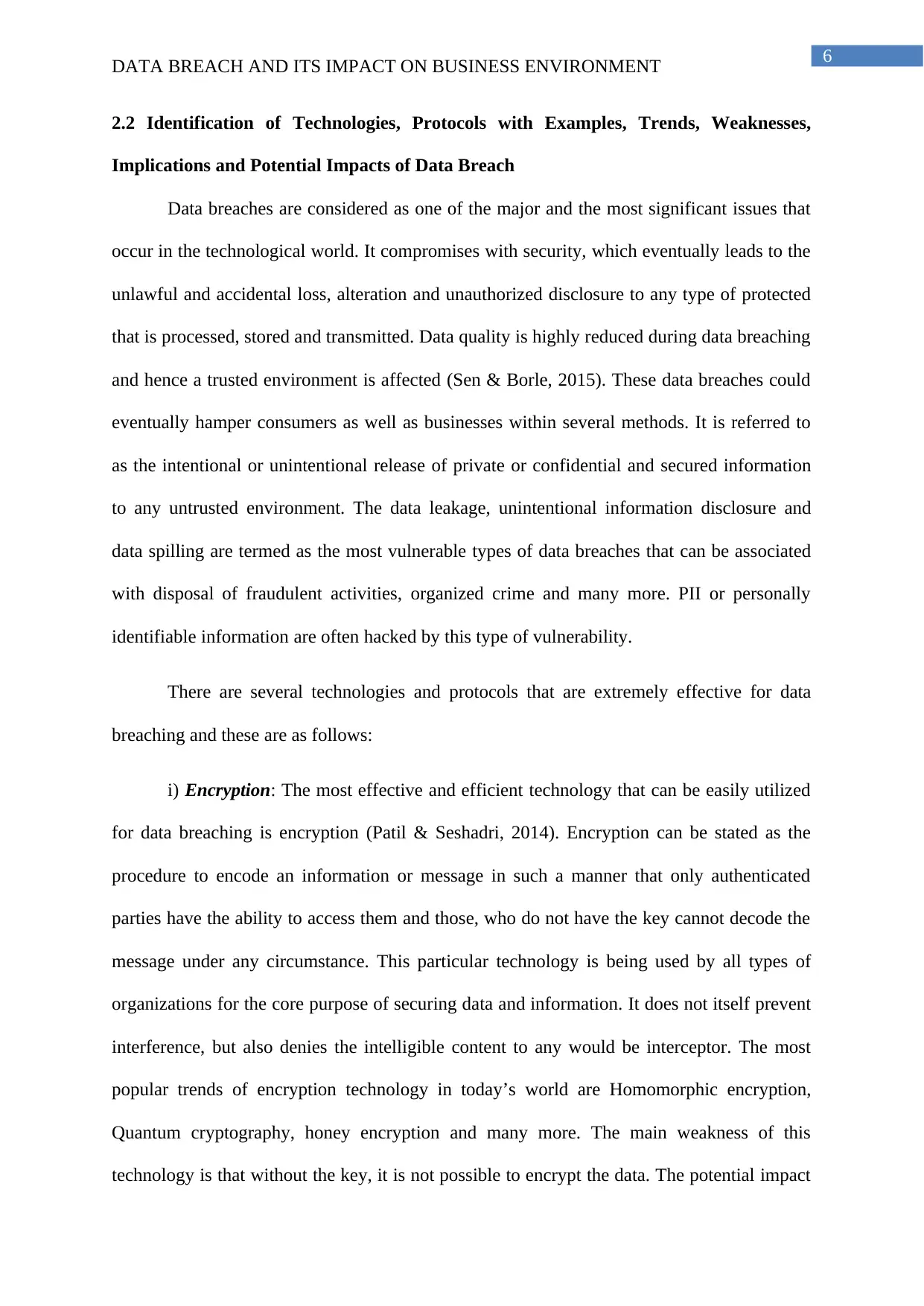
6
DATA BREACH AND ITS IMPACT ON BUSINESS ENVIRONMENT
2.2 Identification of Technologies, Protocols with Examples, Trends, Weaknesses,
Implications and Potential Impacts of Data Breach
Data breaches are considered as one of the major and the most significant issues that
occur in the technological world. It compromises with security, which eventually leads to the
unlawful and accidental loss, alteration and unauthorized disclosure to any type of protected
that is processed, stored and transmitted. Data quality is highly reduced during data breaching
and hence a trusted environment is affected (Sen & Borle, 2015). These data breaches could
eventually hamper consumers as well as businesses within several methods. It is referred to
as the intentional or unintentional release of private or confidential and secured information
to any untrusted environment. The data leakage, unintentional information disclosure and
data spilling are termed as the most vulnerable types of data breaches that can be associated
with disposal of fraudulent activities, organized crime and many more. PII or personally
identifiable information are often hacked by this type of vulnerability.
There are several technologies and protocols that are extremely effective for data
breaching and these are as follows:
i) Encryption: The most effective and efficient technology that can be easily utilized
for data breaching is encryption (Patil & Seshadri, 2014). Encryption can be stated as the
procedure to encode an information or message in such a manner that only authenticated
parties have the ability to access them and those, who do not have the key cannot decode the
message under any circumstance. This particular technology is being used by all types of
organizations for the core purpose of securing data and information. It does not itself prevent
interference, but also denies the intelligible content to any would be interceptor. The most
popular trends of encryption technology in today’s world are Homomorphic encryption,
Quantum cryptography, honey encryption and many more. The main weakness of this
technology is that without the key, it is not possible to encrypt the data. The potential impact
DATA BREACH AND ITS IMPACT ON BUSINESS ENVIRONMENT
2.2 Identification of Technologies, Protocols with Examples, Trends, Weaknesses,
Implications and Potential Impacts of Data Breach
Data breaches are considered as one of the major and the most significant issues that
occur in the technological world. It compromises with security, which eventually leads to the
unlawful and accidental loss, alteration and unauthorized disclosure to any type of protected
that is processed, stored and transmitted. Data quality is highly reduced during data breaching
and hence a trusted environment is affected (Sen & Borle, 2015). These data breaches could
eventually hamper consumers as well as businesses within several methods. It is referred to
as the intentional or unintentional release of private or confidential and secured information
to any untrusted environment. The data leakage, unintentional information disclosure and
data spilling are termed as the most vulnerable types of data breaches that can be associated
with disposal of fraudulent activities, organized crime and many more. PII or personally
identifiable information are often hacked by this type of vulnerability.
There are several technologies and protocols that are extremely effective for data
breaching and these are as follows:
i) Encryption: The most effective and efficient technology that can be easily utilized
for data breaching is encryption (Patil & Seshadri, 2014). Encryption can be stated as the
procedure to encode an information or message in such a manner that only authenticated
parties have the ability to access them and those, who do not have the key cannot decode the
message under any circumstance. This particular technology is being used by all types of
organizations for the core purpose of securing data and information. It does not itself prevent
interference, but also denies the intelligible content to any would be interceptor. The most
popular trends of encryption technology in today’s world are Homomorphic encryption,
Quantum cryptography, honey encryption and many more. The main weakness of this
technology is that without the key, it is not possible to encrypt the data. The potential impact
Paraphrase This Document
Need a fresh take? Get an instant paraphrase of this document with our AI Paraphraser
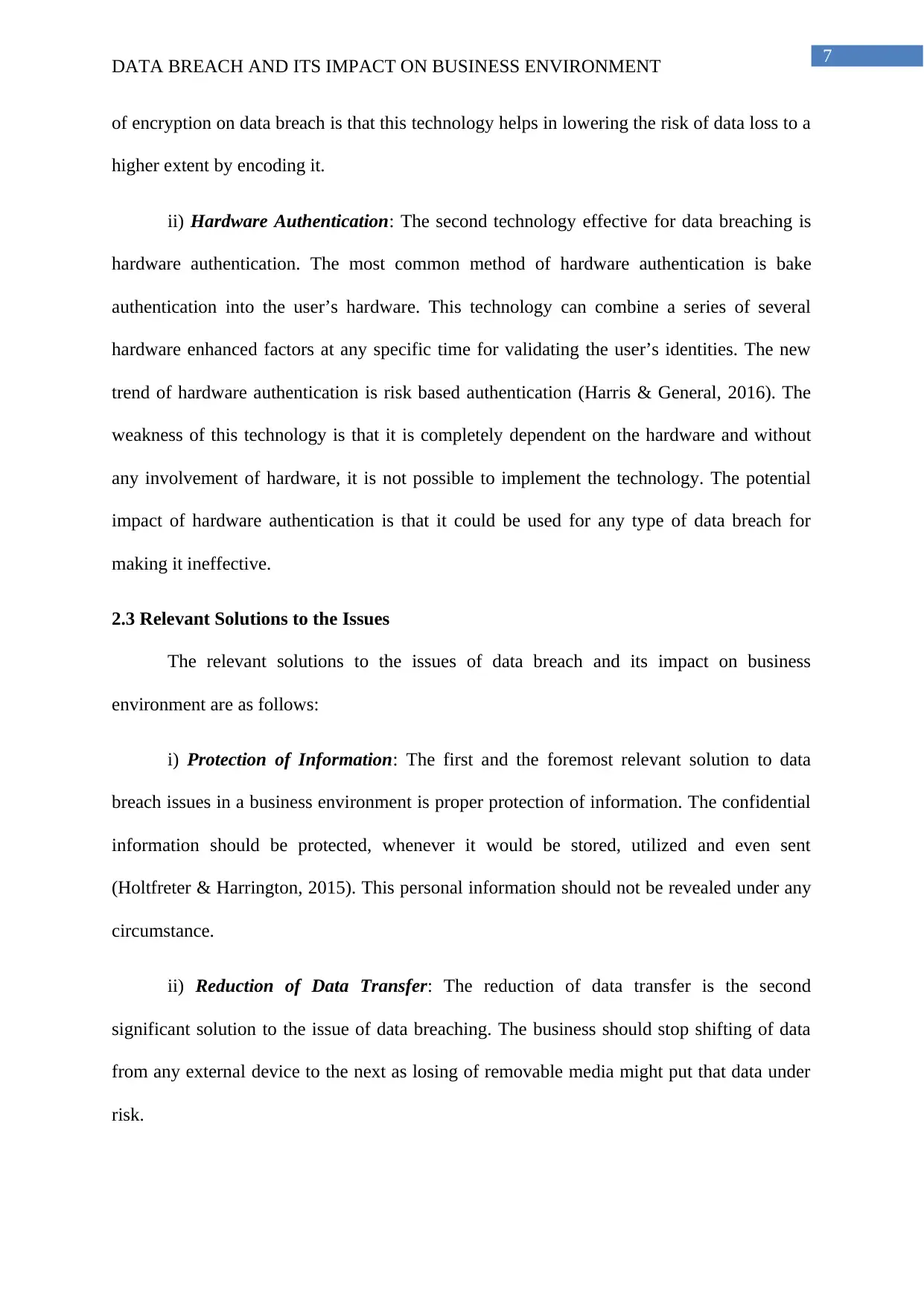
7
DATA BREACH AND ITS IMPACT ON BUSINESS ENVIRONMENT
of encryption on data breach is that this technology helps in lowering the risk of data loss to a
higher extent by encoding it.
ii) Hardware Authentication: The second technology effective for data breaching is
hardware authentication. The most common method of hardware authentication is bake
authentication into the user’s hardware. This technology can combine a series of several
hardware enhanced factors at any specific time for validating the user’s identities. The new
trend of hardware authentication is risk based authentication (Harris & General, 2016). The
weakness of this technology is that it is completely dependent on the hardware and without
any involvement of hardware, it is not possible to implement the technology. The potential
impact of hardware authentication is that it could be used for any type of data breach for
making it ineffective.
2.3 Relevant Solutions to the Issues
The relevant solutions to the issues of data breach and its impact on business
environment are as follows:
i) Protection of Information: The first and the foremost relevant solution to data
breach issues in a business environment is proper protection of information. The confidential
information should be protected, whenever it would be stored, utilized and even sent
(Holtfreter & Harrington, 2015). This personal information should not be revealed under any
circumstance.
ii) Reduction of Data Transfer: The reduction of data transfer is the second
significant solution to the issue of data breaching. The business should stop shifting of data
from any external device to the next as losing of removable media might put that data under
risk.
DATA BREACH AND ITS IMPACT ON BUSINESS ENVIRONMENT
of encryption on data breach is that this technology helps in lowering the risk of data loss to a
higher extent by encoding it.
ii) Hardware Authentication: The second technology effective for data breaching is
hardware authentication. The most common method of hardware authentication is bake
authentication into the user’s hardware. This technology can combine a series of several
hardware enhanced factors at any specific time for validating the user’s identities. The new
trend of hardware authentication is risk based authentication (Harris & General, 2016). The
weakness of this technology is that it is completely dependent on the hardware and without
any involvement of hardware, it is not possible to implement the technology. The potential
impact of hardware authentication is that it could be used for any type of data breach for
making it ineffective.
2.3 Relevant Solutions to the Issues
The relevant solutions to the issues of data breach and its impact on business
environment are as follows:
i) Protection of Information: The first and the foremost relevant solution to data
breach issues in a business environment is proper protection of information. The confidential
information should be protected, whenever it would be stored, utilized and even sent
(Holtfreter & Harrington, 2015). This personal information should not be revealed under any
circumstance.
ii) Reduction of Data Transfer: The reduction of data transfer is the second
significant solution to the issue of data breaching. The business should stop shifting of data
from any external device to the next as losing of removable media might put that data under
risk.
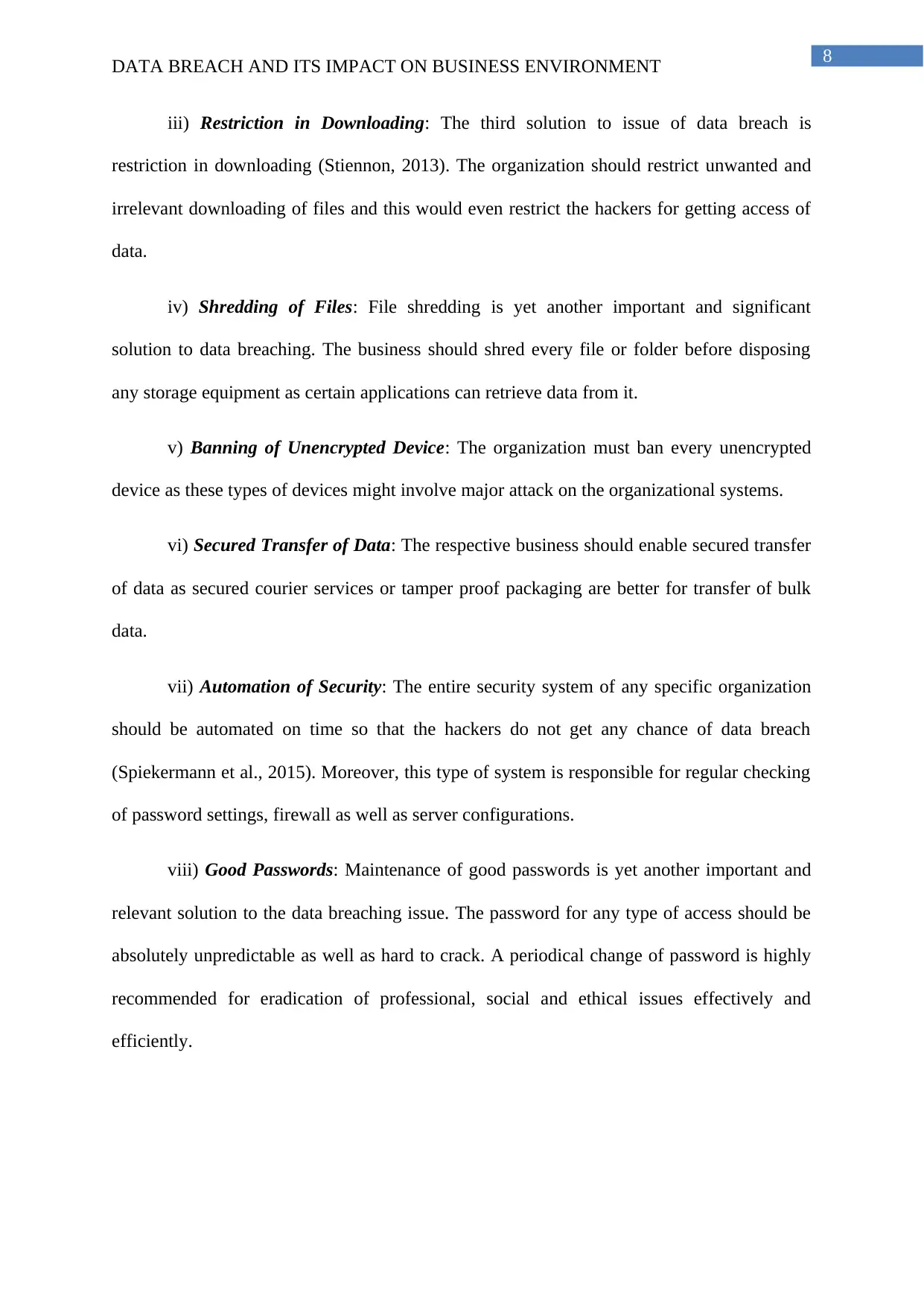
8
DATA BREACH AND ITS IMPACT ON BUSINESS ENVIRONMENT
iii) Restriction in Downloading: The third solution to issue of data breach is
restriction in downloading (Stiennon, 2013). The organization should restrict unwanted and
irrelevant downloading of files and this would even restrict the hackers for getting access of
data.
iv) Shredding of Files: File shredding is yet another important and significant
solution to data breaching. The business should shred every file or folder before disposing
any storage equipment as certain applications can retrieve data from it.
v) Banning of Unencrypted Device: The organization must ban every unencrypted
device as these types of devices might involve major attack on the organizational systems.
vi) Secured Transfer of Data: The respective business should enable secured transfer
of data as secured courier services or tamper proof packaging are better for transfer of bulk
data.
vii) Automation of Security: The entire security system of any specific organization
should be automated on time so that the hackers do not get any chance of data breach
(Spiekermann et al., 2015). Moreover, this type of system is responsible for regular checking
of password settings, firewall as well as server configurations.
viii) Good Passwords: Maintenance of good passwords is yet another important and
relevant solution to the data breaching issue. The password for any type of access should be
absolutely unpredictable as well as hard to crack. A periodical change of password is highly
recommended for eradication of professional, social and ethical issues effectively and
efficiently.
DATA BREACH AND ITS IMPACT ON BUSINESS ENVIRONMENT
iii) Restriction in Downloading: The third solution to issue of data breach is
restriction in downloading (Stiennon, 2013). The organization should restrict unwanted and
irrelevant downloading of files and this would even restrict the hackers for getting access of
data.
iv) Shredding of Files: File shredding is yet another important and significant
solution to data breaching. The business should shred every file or folder before disposing
any storage equipment as certain applications can retrieve data from it.
v) Banning of Unencrypted Device: The organization must ban every unencrypted
device as these types of devices might involve major attack on the organizational systems.
vi) Secured Transfer of Data: The respective business should enable secured transfer
of data as secured courier services or tamper proof packaging are better for transfer of bulk
data.
vii) Automation of Security: The entire security system of any specific organization
should be automated on time so that the hackers do not get any chance of data breach
(Spiekermann et al., 2015). Moreover, this type of system is responsible for regular checking
of password settings, firewall as well as server configurations.
viii) Good Passwords: Maintenance of good passwords is yet another important and
relevant solution to the data breaching issue. The password for any type of access should be
absolutely unpredictable as well as hard to crack. A periodical change of password is highly
recommended for eradication of professional, social and ethical issues effectively and
efficiently.
⊘ This is a preview!⊘
Do you want full access?
Subscribe today to unlock all pages.

Trusted by 1+ million students worldwide
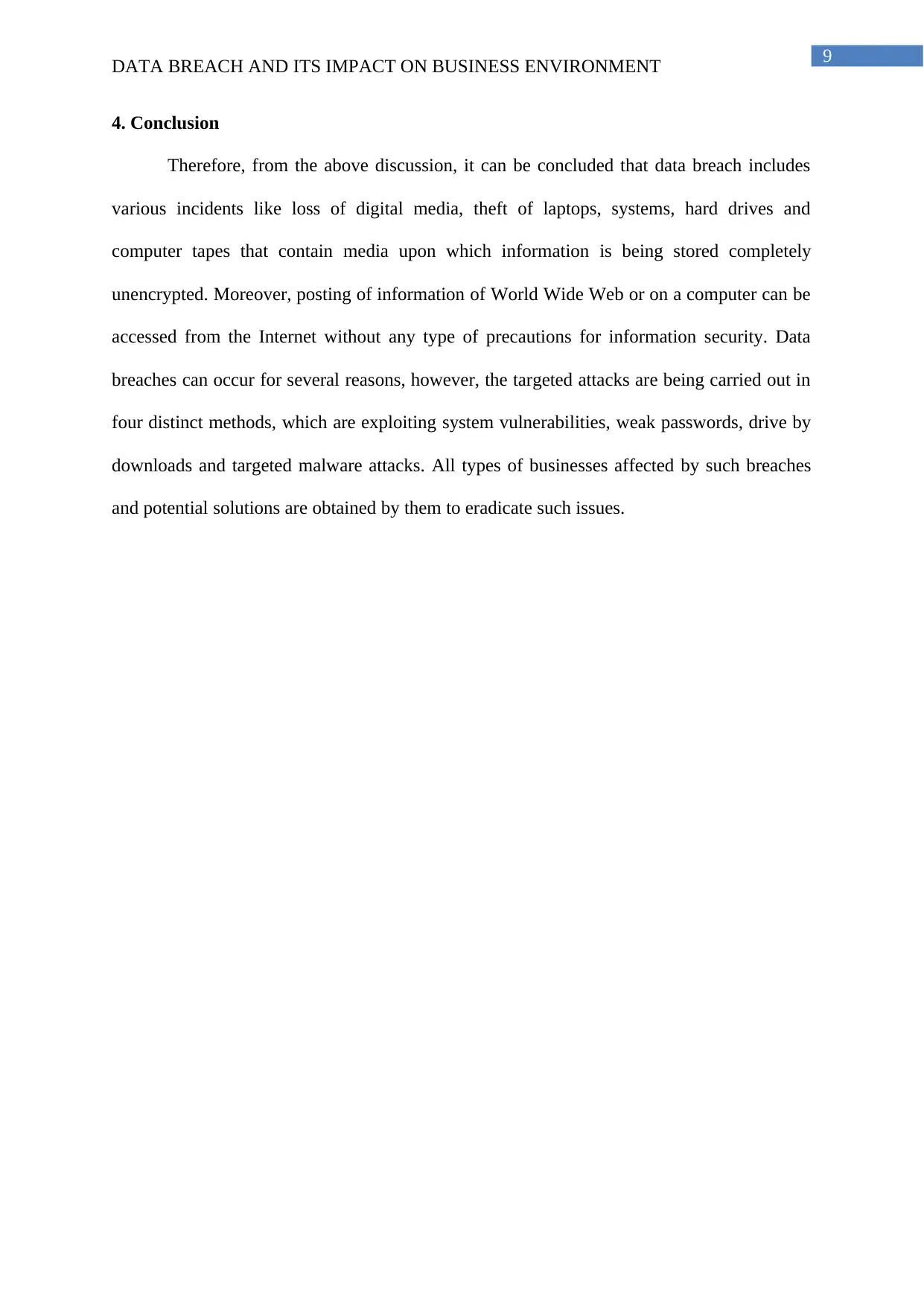
9
DATA BREACH AND ITS IMPACT ON BUSINESS ENVIRONMENT
4. Conclusion
Therefore, from the above discussion, it can be concluded that data breach includes
various incidents like loss of digital media, theft of laptops, systems, hard drives and
computer tapes that contain media upon which information is being stored completely
unencrypted. Moreover, posting of information of World Wide Web or on a computer can be
accessed from the Internet without any type of precautions for information security. Data
breaches can occur for several reasons, however, the targeted attacks are being carried out in
four distinct methods, which are exploiting system vulnerabilities, weak passwords, drive by
downloads and targeted malware attacks. All types of businesses affected by such breaches
and potential solutions are obtained by them to eradicate such issues.
DATA BREACH AND ITS IMPACT ON BUSINESS ENVIRONMENT
4. Conclusion
Therefore, from the above discussion, it can be concluded that data breach includes
various incidents like loss of digital media, theft of laptops, systems, hard drives and
computer tapes that contain media upon which information is being stored completely
unencrypted. Moreover, posting of information of World Wide Web or on a computer can be
accessed from the Internet without any type of precautions for information security. Data
breaches can occur for several reasons, however, the targeted attacks are being carried out in
four distinct methods, which are exploiting system vulnerabilities, weak passwords, drive by
downloads and targeted malware attacks. All types of businesses affected by such breaches
and potential solutions are obtained by them to eradicate such issues.
Paraphrase This Document
Need a fresh take? Get an instant paraphrase of this document with our AI Paraphraser
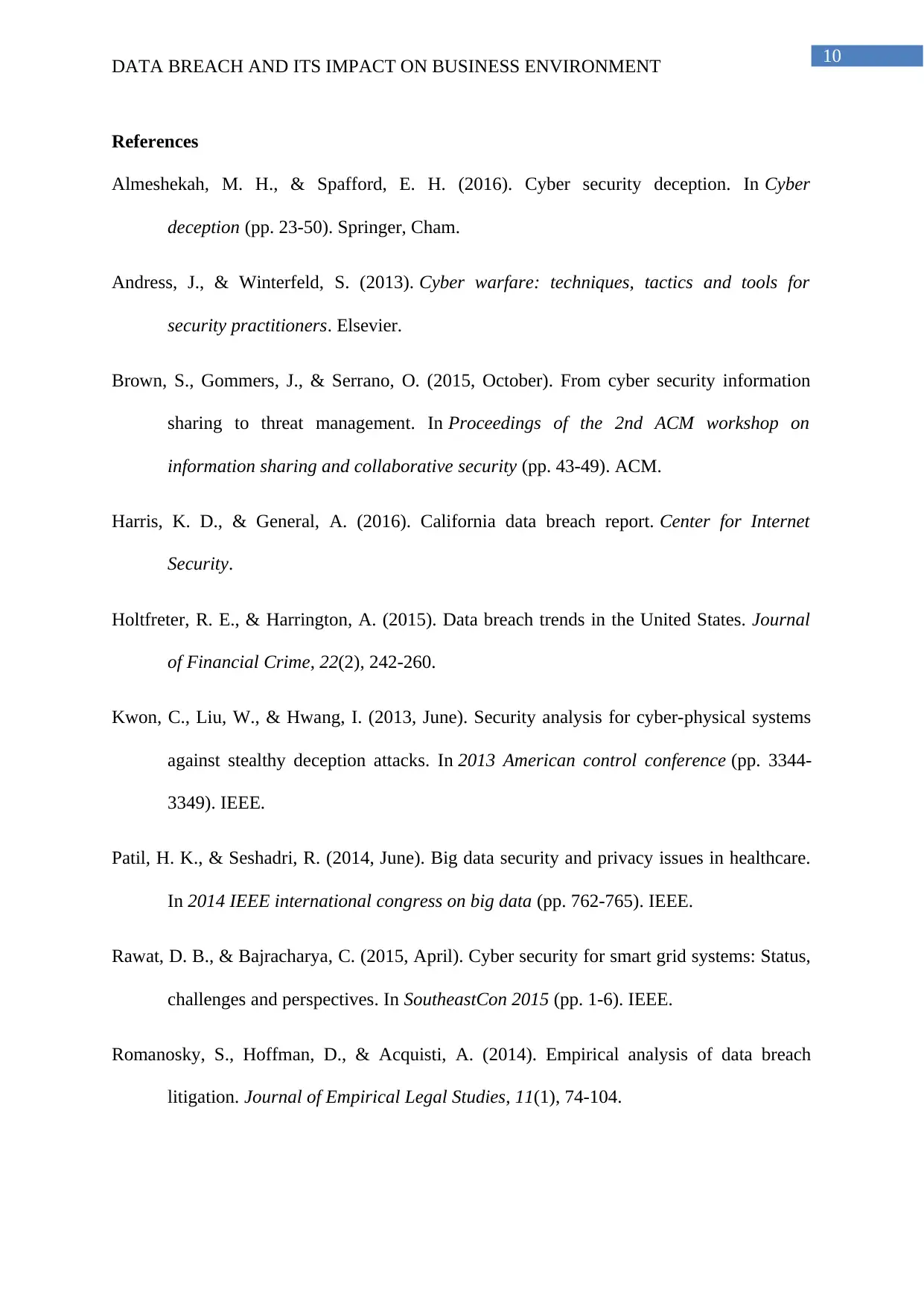
10
DATA BREACH AND ITS IMPACT ON BUSINESS ENVIRONMENT
References
Almeshekah, M. H., & Spafford, E. H. (2016). Cyber security deception. In Cyber
deception (pp. 23-50). Springer, Cham.
Andress, J., & Winterfeld, S. (2013). Cyber warfare: techniques, tactics and tools for
security practitioners. Elsevier.
Brown, S., Gommers, J., & Serrano, O. (2015, October). From cyber security information
sharing to threat management. In Proceedings of the 2nd ACM workshop on
information sharing and collaborative security (pp. 43-49). ACM.
Harris, K. D., & General, A. (2016). California data breach report. Center for Internet
Security.
Holtfreter, R. E., & Harrington, A. (2015). Data breach trends in the United States. Journal
of Financial Crime, 22(2), 242-260.
Kwon, C., Liu, W., & Hwang, I. (2013, June). Security analysis for cyber-physical systems
against stealthy deception attacks. In 2013 American control conference (pp. 3344-
3349). IEEE.
Patil, H. K., & Seshadri, R. (2014, June). Big data security and privacy issues in healthcare.
In 2014 IEEE international congress on big data (pp. 762-765). IEEE.
Rawat, D. B., & Bajracharya, C. (2015, April). Cyber security for smart grid systems: Status,
challenges and perspectives. In SoutheastCon 2015 (pp. 1-6). IEEE.
Romanosky, S., Hoffman, D., & Acquisti, A. (2014). Empirical analysis of data breach
litigation. Journal of Empirical Legal Studies, 11(1), 74-104.
DATA BREACH AND ITS IMPACT ON BUSINESS ENVIRONMENT
References
Almeshekah, M. H., & Spafford, E. H. (2016). Cyber security deception. In Cyber
deception (pp. 23-50). Springer, Cham.
Andress, J., & Winterfeld, S. (2013). Cyber warfare: techniques, tactics and tools for
security practitioners. Elsevier.
Brown, S., Gommers, J., & Serrano, O. (2015, October). From cyber security information
sharing to threat management. In Proceedings of the 2nd ACM workshop on
information sharing and collaborative security (pp. 43-49). ACM.
Harris, K. D., & General, A. (2016). California data breach report. Center for Internet
Security.
Holtfreter, R. E., & Harrington, A. (2015). Data breach trends in the United States. Journal
of Financial Crime, 22(2), 242-260.
Kwon, C., Liu, W., & Hwang, I. (2013, June). Security analysis for cyber-physical systems
against stealthy deception attacks. In 2013 American control conference (pp. 3344-
3349). IEEE.
Patil, H. K., & Seshadri, R. (2014, June). Big data security and privacy issues in healthcare.
In 2014 IEEE international congress on big data (pp. 762-765). IEEE.
Rawat, D. B., & Bajracharya, C. (2015, April). Cyber security for smart grid systems: Status,
challenges and perspectives. In SoutheastCon 2015 (pp. 1-6). IEEE.
Romanosky, S., Hoffman, D., & Acquisti, A. (2014). Empirical analysis of data breach
litigation. Journal of Empirical Legal Studies, 11(1), 74-104.
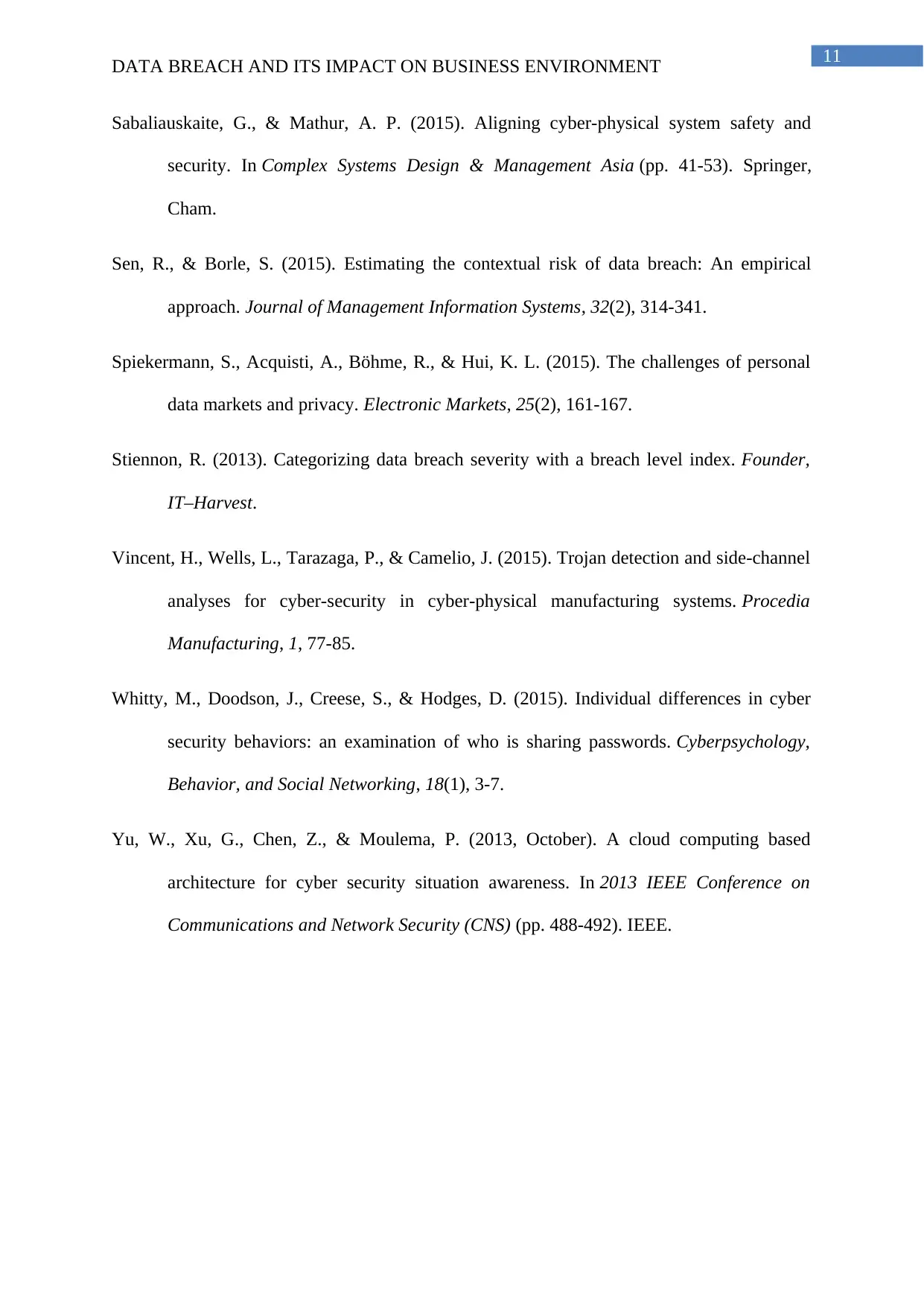
11
DATA BREACH AND ITS IMPACT ON BUSINESS ENVIRONMENT
Sabaliauskaite, G., & Mathur, A. P. (2015). Aligning cyber-physical system safety and
security. In Complex Systems Design & Management Asia (pp. 41-53). Springer,
Cham.
Sen, R., & Borle, S. (2015). Estimating the contextual risk of data breach: An empirical
approach. Journal of Management Information Systems, 32(2), 314-341.
Spiekermann, S., Acquisti, A., Böhme, R., & Hui, K. L. (2015). The challenges of personal
data markets and privacy. Electronic Markets, 25(2), 161-167.
Stiennon, R. (2013). Categorizing data breach severity with a breach level index. Founder,
IT–Harvest.
Vincent, H., Wells, L., Tarazaga, P., & Camelio, J. (2015). Trojan detection and side-channel
analyses for cyber-security in cyber-physical manufacturing systems. Procedia
Manufacturing, 1, 77-85.
Whitty, M., Doodson, J., Creese, S., & Hodges, D. (2015). Individual differences in cyber
security behaviors: an examination of who is sharing passwords. Cyberpsychology,
Behavior, and Social Networking, 18(1), 3-7.
Yu, W., Xu, G., Chen, Z., & Moulema, P. (2013, October). A cloud computing based
architecture for cyber security situation awareness. In 2013 IEEE Conference on
Communications and Network Security (CNS) (pp. 488-492). IEEE.
DATA BREACH AND ITS IMPACT ON BUSINESS ENVIRONMENT
Sabaliauskaite, G., & Mathur, A. P. (2015). Aligning cyber-physical system safety and
security. In Complex Systems Design & Management Asia (pp. 41-53). Springer,
Cham.
Sen, R., & Borle, S. (2015). Estimating the contextual risk of data breach: An empirical
approach. Journal of Management Information Systems, 32(2), 314-341.
Spiekermann, S., Acquisti, A., Böhme, R., & Hui, K. L. (2015). The challenges of personal
data markets and privacy. Electronic Markets, 25(2), 161-167.
Stiennon, R. (2013). Categorizing data breach severity with a breach level index. Founder,
IT–Harvest.
Vincent, H., Wells, L., Tarazaga, P., & Camelio, J. (2015). Trojan detection and side-channel
analyses for cyber-security in cyber-physical manufacturing systems. Procedia
Manufacturing, 1, 77-85.
Whitty, M., Doodson, J., Creese, S., & Hodges, D. (2015). Individual differences in cyber
security behaviors: an examination of who is sharing passwords. Cyberpsychology,
Behavior, and Social Networking, 18(1), 3-7.
Yu, W., Xu, G., Chen, Z., & Moulema, P. (2013, October). A cloud computing based
architecture for cyber security situation awareness. In 2013 IEEE Conference on
Communications and Network Security (CNS) (pp. 488-492). IEEE.
⊘ This is a preview!⊘
Do you want full access?
Subscribe today to unlock all pages.

Trusted by 1+ million students worldwide
1 out of 15
Related Documents
Your All-in-One AI-Powered Toolkit for Academic Success.
+13062052269
info@desklib.com
Available 24*7 on WhatsApp / Email
![[object Object]](/_next/static/media/star-bottom.7253800d.svg)
Unlock your academic potential
Copyright © 2020–2025 A2Z Services. All Rights Reserved. Developed and managed by ZUCOL.





